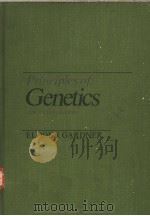《PRINCIPLES OF POLYMERIZATION FOURTH EDITION》
| 作者 | 编者 |
|---|---|
| 出版 | 未查询到或未知 |
| 参考页数 | 812 |
| 出版时间 | 没有确切时间的资料 目录预览 |
| ISBN号 | 0471274003 — 求助条款 |
| PDF编号 | 812307488(仅供预览,未存储实际文件) |
| 求助格式 | 扫描PDF(若分多册发行,每次仅能受理1册) |

1INTRODUCTION1
1-1Types of Polymers and Polymerizations1
1-1a Polymer Composition and Structure2
1-1b Polymerization Mechanism6
1-2Nomenclature of Polymers9
1-2a Nomenclature Based on Source10
1-2b Nomenclature Based on Structure (Non-IUPAC)11
1-2c IUPAC Structure-Based Nomenclature System11
1-2d Trade Names and Nonnames16
1-3 Linear, Branched, and Crosslinked Polymers17
1-4 Molecular Weight19
1-5Physical State24
1-5a Crystalline and Amorphous Behavior24
1-5b Determinants of Polymer Crystallinity27
1-5c Thermal Transitions29
1-6Applications of Polymers32
1-6a Mechanical Properties32
1-6b Elastomers, Fibers, and Plastics35
References36
2STEP POLYMERIZATION39
2-1Reactivity of Functional Groups40
2-1a Basis for Analysis of Polymerization Kinetics40
2-1b Experimental Evidence41
2-1c Theoretical Considerations43
2-1d Equivalence of Groups in Bifunctional Reactants44
2-2Kinetics of Step Polymerization44
2-2aSelf-Catalyzed Polymerization46
2-2a-1 Experimental Observations47
2-2a-2 Reasons for Nonlinearity in Third-Order Plot48
2-2a-3 Molecular Weight of Polymer50
2-2b External Catalysis of Polymerization51
2-2c Step Polymerizations Other than Polyesterification:Catalyzed versus Uncatalyzed53
2-2dNonequivalence of Functional Groups in Polyfunctional Reagents54
2-2d-1 Examples of Nonequivalence54
2-2d-2 Kinetics57
2-3 Accessibility of Functional Groups63
2-4Equilibrium Considerations65
2-4a Closed System65
2-4b Open, Driven System67
2-4c Kinetics of Reversible Polymerization69
2-5Cyclization versus Linear Polymerization69
2-5a Possible Cyclization Reactions69
2-5b Cyclization Tendency versus Ring Size70
2-5c Reaction Conditions72
2-5d Thermodynamic versus Kinetic Control73
2-5e Other Considerations74
2-6Molecular Weight Control in Linear Polymerization74
2-6a Need for Stoichiometric Control74
2-6b Quantitative Aspects75
2-6c Kinetics of Nonstoichiometric Polymerization79
2-7Molecular Weight Distribution in Linear Polymerization80
2-7a Derivation of Size Distributions80
2-7b Breadth of Molecular Weight Distribution82
2-7c Interchange Reactions83
2-7d Alternate Approaches for Molecular-Weight Distribution83
2-7eEffect of Reaction Variables on MWD86
2-7e-1 Unequal Reactivity of Functional Groups86
2-7e-2 Change in Reactivity on Reaction86
2-7e-3 Nonstoichiometry of Functional Groups86
2-8Process Conditions87
2-8a Physical Nature of Polymerization Systems87
2-8b Different Reactant Systems89
2-8cInterfacial Polymerization90
2-8c-1 Description of Process90
2-8c-2 Utility92
2-8d Polyesters92
2-8e Polycarbonates96
2-8f Polyamides97
2-8g Historical Aspects101
2-9Multichain Polymerization101
2-9a Branching101
2-9b Molecular Weight Distribution102
2-10Crosslinking103
2-10aCarothers Equation: Xn → ∞105
2-10a-1 Stoichiometric Amounts of Reactants105
2-10a-2 Extension to Nonstoichiometric Reactant Mixtures106
2-10b Statistical Approach to Gelation: Xw → ∞108
2-10c Experimental Gel Points111
2-10d Extensions of Statistical Approach112
2-11 Molecular Weight Distributions in Nonlinear Polymerizations114
2-12Crosslinking Technology117
2-12a Polyesters, Unsaturated Polyesters, and Alkyds118
2-12bPhenolic Polymers120
2-12b-1 Resole Phenolics120
2-12b-2 Novolac Phenolics124
2-12b-3 Applications126
2-12c Amino Plastics126
2-12d Epoxy Resins128
2-12e Polyurethanes130
2-12f Polysiloxanes132
2-12g Polysulfides134
2-13Step Copolymerization135
2-13a Types of Copolymers135
2-13bMethods of Synthesizing Copolymers138
2-13b-1 Statistical Copolymers138
2-13b-2 Alternating Copolymers138
2-13b-3 Block Copolymers139
2-13cUtility of Copolymerization140
2-13c-1 Statistical Copolymers141
2-13c-2 Block Copolymers142
2-13c-3 Polymer Blends and Interpenetrating Polymer Networks143
2-13c-4 Constitutional Isomerism144
2-14High-Performance Polymers144
2-14a Requirements for High-Temperature Polymers144
2-14b Aromatic Polyethers by Oxidative Coupling146
2-14c Aromatic Polyethers by Nucleophilic Substitution149
2-14d Aromatic Polysulfides151
2-14e Aromatic Polyimides151
2-14f Reactive Telechelic Oligomer Approach155
2-14g Liquid Crystal Polymers157
2-14h 5-Membered Ring Heterocyclic Polymers159
2-14i 6-Membered Ring Heterocyclic Polymers162
2-14jConjugated Polymers163
2-14j-1 Oxidative Polymerization of Aniline165
2-14j-2 Poly(p-phenylene)166
2-14j-3 Poly(p-phenylene Vinylene)167
2-15Inorganic and Organometallic Polymers168
2-15aInorganic Polymers168
2-15a-1 Minerals168
2-15a-2 Glasses169
2-15a-3 Ceramics170
2-15bOrganometallic Polymers172
2-15b-1 Polymerization via Reaction at Metal Bond172
2-15b-2 Polymerization without Reaction at Metal Bond173
2-15b-3 Polysilanes173
2-16Dendritic (Highly Branched) Polymers174
2-16a Random Hyperbranched Polymers175
2-16b Dendrimers177
2-17Miscellaneous Topics180
2-17aEnzymatic Polymerizations180
2-17a-1 In Vivo (within Living Cells)180
2-17a-2 In Vitro (outside Living Cells)181
2-17b Polymerization in Supercritical Carbon Dioxide183
2-17c Cycloaddition (Four-Center) Polymerization183
2-17d Spiro Polymers184
2-17e Pseudopolyrotoxanes and Polyrotoxanes184
References185
3RADICAL CHAIN POLYMERIZATION198
3-1Nature of Radical Chain Polymerization199
3-1a Comparison of Chain and Step Polymerizations199
3-1bRadical versus Ionic Chain Polymerizations199
3-1b-1 General Considerations of Polymerizability199
3-1b-2 Effects of Substituents200
3-2Structural Arrangement of Monomer Units202
3-2a Possible Modes of Propagation202
3-2b Experimental Evidence203
3-2c Synthesis of Head-to-Head Polymers204
3-3Rate of Radical Chain Polymerization204
3-3a Sequence of Events204
3-3b Rate Expression206
3-3cExperimental Determination of Rp208
3-3c-1 Physical Separation and Isolation of Reaction Product208
3-3c-2 Chemical and Spectroscopic Analysis208
3-3c-3 Other Techniques209
3-4Initiation209
3-4aThermal Decomposition of Initiators209
3-4a-1 Types of Initiators209
3-4a-2 Kinetics of Initiation and Polymerization212
3-4a-3 Dependence of Polymerization Rate on Initiator212
3-4a-4 Dependence of Polymerization Rate on Monomer214
3-4bRedox Initiation216
3-4b-1 Types of Redox Initiators216
3-4b-2 Rate of Redox Polymerization217
3-4cPhotochemical Initiation218
3-4c-1 Bulk Monomer219
3-4c-2 Irradiation of Thermal and Redox Initiators220
3-4c-3 Rate of Photopolymerization221
3-4d Initiation by Ionizing Radiation224
3-4e Pure Thermal Initiation226
3-4f Other Methods of Initiation227
3-4gInitiator Efficiency228
3-4g-1 Definition off228
3-4g-2 Mechanism off < 1: Cage Effect228
3-4g-3 Experimental Determination off232
3-4h Other Aspects of Initiation235
3-5Molecular Weight236
3-5a Kinetic Chain Length236
3-5b Mode of Termination236
3-6Chain Transfer238
3-6a Effect of Chain Transfer238
3-6bTransfer to Monomer and Initiator240
3-6b-1 Determination of CM and Cl240
3-6b-2 Monomer Transfer Constants241
3-6b-3 Initiator Transfer Constants244
3-6cTransfer to Chain-Transfer Agent245
3-6c-1 Determination of Cs245
3-6c-2 Structure and Reactivity246
3-6c-3 Practical Utility of Mayo Equation249
3-6d Chain Transfer to Polymer250
3-6e Catalytic Chain Transfer254
3-7Inhibition and Retardation255
3-7a Kinetics of Inhibition or Retardation256
3-7b Types of Inhibitors and Retarders259
3-7c Autoinhibition of Allylic Monomers263
3-8Determination of Absolute Rate Constants264
3-8a Non-Steady-State Kinetics264
3-8b Rotating Sector Method265
3-8c PLP-SEC Method267
3-8d Typical Values of Reaction Parameters269
3-9Energetic Characteristics271
3-9aActivation Energy and Frequency Factor271
3-9a-1 Rate of Polymerization272
3-9a-2 Degree of Polymerization274
3-9bThermodynamics of Polymerization275
3-9b-1 Significance of △G, △H, and △S275
3-9b-2 Effect of Monomer Structure276
3-9b-3 Polymerization of 1,2-Disubstituted Ethylenes277
3-9cPolymerization-Depolymerization Equilibria279
3-9c-1 Ceiling Temperature279
3-9c-2 Floor Temperature282
3-10Autoacceleration282
3-10a Course of Polymerization282
3-10b Diffusion-Controlled Termination283
3-10c Effect of Reaction Conditions286
3-10d Related Phenomena287
3-10d-1Occlusion (Heterogeneous) Polymerization287
3-10d-2 Template Polymerization287
3-10e Dependence of Polymerization Rate on Initiator and Monomer288
3-10f Other Accelerative Phenomena289
3-11Molecular Weight Distribution289
3-11a Low-Conversion Polymerization289
3-11b High-Conversion Polymerization292
3-12Effect of Pressure292
3-12aEffect on Rate Constants293
3-12a-1 Volume of Activation293
3-12a-2 Rate of Polymerization294
3-12a-3 Degree of Polymerization295
3-12b Thermodynamics of Polymerization296
3-12c Other Effects of Pressure296
3-13Process Conditions296
3-13a Bulk (Mass) Polymerization297
3-13b Solution Polymerization297
3-13c Heterogeneous Polymerization297
3-13d Other Processes; Self-Assembly and Nanostructures299
3-14Specific Commercial Polymers300
3-14a Polyethylene300
3-14b Polystyrene302
3-14cVinyl Family304
3-14c-1 Poly(vinyl chloride)304
3-14c-2 Other Members of Vinyl Family306
3-14dAcrylic Family307
3-14d-1 Acrylate and Methacrylate Products307
3-14d-2 Polyacrylonitrile308
3-14d-3 Other Members of Acrylic Family308
3-14e Fluoropolymers309
3-14f Polymerization of Dienes310
3-14gMiscellaneous Polymers311
3-14g-1 Poly(p-xylylene)311
3-14g-2 Poly(N-vinylcarbazole)313
3-14g-3 Poly(N-vinylpyrrolidinone)313
3-15Living Radical Polymerization313
3-15a General Considerations313
3-15bAtom Transfer Radical Polymerization (ATRP)316
3-15b-1 Polymerization Mechanism316
3-15b-2 Effects of Components of Reaction System319
3-15b-3 Complex Kinetics321
3-15b-4 Block Copolymers322
3-15b-5 Other Polymer Architectures324
3-15c Stable Free-Radical Polymerization (SFRP)325
3-15d Radical Addition-Fragmentation Transfer (RAFT)328
3-15e Other Living Radical Polymerizations330
3-16Other Polymerizations330
3-16a Organometallic Polymers330
3-16b Functional Polymers330
3-16c Acetylenic Monomers332
References332
4EMULSION POLYMERIZATION350
4-1Description of Process350
4-1a Utility350
4-1bQualitative Picture351
4-1b-1 Components and Their Locations351
4-1b-2 Site of Polymerization353
4-1b-3 Progress of Polymerization354
4-2Quantitative Aspects356
4-2a Rate of Polymerization356
4-2b Degree of Polymerization360
4-2c Number of Polymer Particles362
4-3Other Characteristics of Emulsion Polymerization363
4-3a Initiators363
4-3b Surfactants363
4-3c Other Components364
4-3d Propagation and Termination Rate Constants364
4-3e Energetics365
4-3f Molecular Weight and Particle Size Distributions365
4-3g Surfactant-Free Emulsion Polymerization366
4-3h Other Emulsion Polymerization Systems367
4-3i Living Radical Polymerization368
References369
5IONIC CHAIN POLYMERIZATION372
5-1 Comparison of Radical and Ionic Polymerizations372
5-2Cationic Polymerization of the Carbon-Carbon Double Bond374
5-2aInitiation374
5-2a-1 Protonic Acids374
5-2a-2 Lewis Acids375
5-2a-3 Halogen379
5-2a-4 Photoinitiation by Onium Salts379
5-2a-5 Electroinitiation380
5-2a-6 Ionizing Radiation381
5-2b Propagation382
5-2cChain Transfer and Termination384
5-2c-1 β-Proton Transfer384
5-2c-2 Combination with Counterion386
5-2c-3 Chain Transfer to Polymer387
5-2c-4 Other Transfer and Termination Reactions387
5-2dKinetics388
5-2d-1 Different Kinetic Situations388
5-2d-2 Validity of Steady-State Assumption391
5-2d-3 Molecular Weight Distribution391
5-2eAbsolute Rate Constants392
5-2e-1 Experimental Methods392
5-2e-2 Diffculty in Interpreting Rate Constants394
5-2e-3 Comparison of Rate Constants396
5-2e-4 CM and Cs Values398
5-2fEffect of Reaction Medium399
5-2f-1 Propagation by Covalent Species;Pseudocationic Polymerization399
5-2f-2 Solvent Effects401
5-2f-3 Counterion Effects403
5-2gLiving Cationic Polymerization403
5-2g-1 General Requirements404
5-2g-2 Rate and Degree of Polymerization405
5-2g-3 Specific Living Cationic Polymerization Systems406
5-2h Energetics408
5-2iCommercial Applications of Cationic Polymerization410
5-2i-1 Polyisobutylene Products410
5-2i-2 Other Products411
5-3Anionic Polymerization of the Carbon-Carbon Double Bond412
5-3aInitiation412
5-3a-1 Nucleophilic Initiators412
5-3a-2 Electron Transfer414
5-3bTermination416
5-3b-1 Polymerizations without Termination416
5-3b-2 Termination by Impurities and Deliberately Added Transfer Agents416
5-3b-3 Spontaneous Termination417
5-3b-4 Termination and Side Reactions of Polar Monomers418
5-3c Group Transfer Polymerization420
5-3dKinetics of Living Polymerization422
5-3d-1 Polymerization Rate422
5-3d-2 Effects of Reaction Media423
5-3d-3 Degree of Polymerization428
5-3d-4 Energetics: Solvent-Separated and Contact Ion Pairs429
5-3d-5 Association Phenomena in Alkyllithium433
5-3d-6 Other Phenomena435
5-4Block and Other Polymer Architectures436
5-4a Sequential Monomer Addition436
5-4b Telechelic (End-Functionalized) Polymers439
5-4c Coupling Reactions441
5-4d Transformation Reactions443
5-5 Distinguishing Between Radical, Cationic, and Anionic Polymerizations443
5-6Carbonyl Polymerization444
5-6aAnionic Polymerization445
5-6a-1 Formaldehyde445
5-6a-2 Other Carbonyl Monomers446
5-6b Cationic Polymerization447
5-6c Radical Polymerization447
5-6d End Capping448
5-7Miscellaneous Polymerizations449
5-7a Monomers with Two Different Polymerizable Groups449
5-7b Hydrogen-Transfer Polymerization of Acrylamide450
5-7c Polymerization and Cyclotrimerization of Isocyanates451
5-7d Monomers with Triple Bonds451
References452
6CHAIN COPOLYMERIZATION464
6-1General Considerations465
6-1a Importance of Chain Copolymerization465
6-1b Types of Copolymers465
6-2Copolymer Composition466
6-2a Terminal Model; Monomer Reactivity Ratios466
6-2b Statistical Derivation of Copolymerization Equation469
6-2c Range of Applicability of Copolymerization Equation470
6-2dTypes of Copolymerization Behavior471
6-2d-1 Ideal Copolymerization: r1 r2=1471
6-2d-2 Alternating Copolymerization: r1 r2=0473
6-2d-3 Block Copolymerization: r1 > 1, r2>1475
6-2e Variation of Copolymer Composition with Conversion475
6-2f Experimental Evaluation of Monomer Reactivity Ratios480
6-2gMicrostructure of Copolymers481
6-2g-1 Sequence Length Distribution481
6-2g-2 Copolymer Compositions of Different Molecules484
6-2h Multicomponent Copolymerization485
6-3Radical Copolymerization487
6-3aEffect of Reaction Conditions487
6-3a-1 Reaction Medium487
6-3a-2 Temperature489
6-3a-3 Pressure490
6-3bReactivity490
6-3b-1 Resonance Effects490
6-3b-2 Steric Effects496
6-3b-3 Alternation; Polar Effects and Complex Participation497
6-3b-4 Q-e Scheme500
6-3b-5 Patterns of Reactivity Scheme503
6-3b-6 Other Quantitative Approaches to Reactivity505
6-3c Terminal Model for Rate of Radical Copolymerization505
6-4Ionic Copolymerization506
6-4aCationic Copolymerization507
6-4a-1 Reactivity507
6-4a-2 Effect of Solvent and Counterion508
6-4a-3 Effect of Temperature510
6-4bAnionic Copolymerization510
6-4b-1 Reactivity510
6-4b-2 Effects of Solvent and Counterion511
6-4b-3 Effect of Temperature512
6-5Deviations from Terminal Copolymerization Model512
6-5a Kinetic Penultimate Behavior513
6-5b Depropagation during Copolymerization515
6-5c Copolymerization with Complex Participation518
6-5d Discrimination between Models521
6-6Copolymerizations Involving Dienes521
6-6a Crosslinking521
6-6b Alternating Intra/intermolecular Polymerization;Cyclopolymerization524
6-6c Interpenetrating Polymer Networks527
6-7Other Copolymerizations528
6-7a Miscellaneous Copolymerizations of Alkenes528
6-7b Copolymerization of Carbonyl Monomers528
6-8Applications of Copolymerization529
6-8a Styrene529
6-8b Ethylene530
6-8c Unsaturated Polyesters531
6-8d Allyl Resins532
6-8e Other Copolymers532
References533
7RING-OPENING POLYMERIZATION544
7-1General Characteristics545
7-1a Scope; Polymerizability545
7-1b Polymerization Mechanism and Kinetics546
7-2Cyclic Ethers548
7-2aAnionic Polymerization of Epoxides548
7-2a-1 Reaction Characteristics548
7-2a-2 Exchange Reactions551
7-2a-3 Chain Transfer to Monomer553
7-2bCationic Polymerization554
7-2b-1 Propagation554
7-2b-2 Initiation555
7-2b-3 Termination and Transfer Processes556
7-2b-4 Cyclic Acetals559
7-2b-5 Kinetics of Reversible ROP562
7-2b-6 Energetic Characteristics565
7-2b-7 Commercial Applications568
7-3Lactams569
7-3a Cationic Polymerization570
7-3b Hydrolytic Polymerization572
7-3cAnionic Polymerization573
7-3c-1 Use of Strong Base Alone573
7-3c-2 Addition of N-Acyllactam575
7-3d Reactivity577
7-4N-Carboxy-α-Amino Acid Anhydrides578
7-4a Polymerization by Bases578
7-4b Polymerization by Transition Metal Complexes580
7-5Lactones581
7-5a Anionic Polymerization581
7-5b Cationic Polymerization583
7-5c Enzymatic Polymerization584
7-5d Other Cyclic Esters585
7-6Nitrogen Heterocyclics586
7-6a Cyclic Amines586
7-6b Other Nitrogen Heterocyclics587
7-7 Sulfur Heterocyclics588
7-8 Cycloalkenes589
7-9 Miscellaneous Oxygen Heterocyclics592
7-10 Other Ring-Opening Polymerizations594
7-11Inorganic and Partially Inorganic Polymers595
7-11a Cyclosiloxanes595
7-11b Cyclotriphosphazenes597
7-11c Metallocenophanes599
7-11d Phosphorus-Containing Cyclic Esters599
7-11e Sulfur and Sulfur Nitride Polymers600
7-12Copolymerization600
7-12a Monomers with Same Functional Group601
7-12b Monomers with Different Functional Groups603
7-12c Block Copolymers604
7-12d Zwitterion Polymerization605
References606
8STEREOCHEMISTRY OF POLYMERIZATION619
8-1Types of Stereoisomerism in Polymers620
8-1aMonosubstituted Ethylenes621
8-1a-1 Site of Steric Isomerism621
8-1a-2 Tacticity622
8-1bDisubstituted Ethylenes624
8-1b-1 1,1-Disubstituted Ethylenes624
8-1b-2 1,2-Disubstituted Ethylenes624
8-1c Carbonyl and Ring-Opening Polymerizations626
8-1d1,3-Butadiene and 2-Substituted 1,3-Butadienes627
8-1d-1 1,2- and 3,4-Polymerizations627
8-1d-2 1,4-Polymerization628
8-1e1-Substituted and 1,4-Disubstituted 1,3-Butadienes629
8-1e-1 1,2- and 3,4-Polymerizations629
8-1e-2 1,4-Polymerization630
8-1f Other Polymers631
8-2Properties of Stereoregular Polymers633
8-2aSignificance of Stereoregularity633
8-2a-1 Isotactic, Syndiotactic, and Atactic Polypropenes633
8-2a-2 Cis- and Trans- 1,4-Poly-1,3-Dienes633
8-2a-3 Cellulose and Amylose634
8-2b Analysis of Stereoregularity635
8-3Forces of Stereoregulation in Alkene Polymerizations637
8-3a Radical Polymerization637
8-3bIonic and Coordination Polymerizations640
8-3b-1 Effect of Coordination640
8-3b-2 Mechanism of Stereoselective Placement641
8-4Traditional Ziegler-Natta Polymerization of Nonpolar Alkene Monomers644
8-4a Historical Development of Ziegler-Natta Initiators644
8-4b Chemical Nature of Propagating Species645
8-4c Primary versus Secondary Insertion; Regioselectivity646
8-4d Propagation at Carbon-Transition Metal Bond647
8-4e Mechanism of Isoselective Propagation647
8-4f Mechanism of Syndioselective Propagation652
8-4g Direction of Double-Bond Opening654
8-4hEffects of Components of Ziegler-Natta Initiator655
8-4h-1 Transition Metal Component656
8-4h-2 Group Ⅰ-Ⅲ Metal Component657
8-4h-3 Third Component: Electron Donor (Lewis Base)658
8-4iKinetics658
8-4i-1 Observed Rate Behavior658
8-4i-2 Termination659
8-4i-3 Rate and Degree of Polymerization661
8-4i-4 Values of Kinetic Parameters662
8-4j Transition Metal Oxide Initiators664
8-5Metallocene Polymerization of Nonpolar Alkene Monomers665
8-5a Metallocene Symmetry666
8-5b C2v-Symmetric Metallocenes668
8-5cC2-Symmetric Metallocenes668
8-5c-1 Effect of Initiator Structure669
8-5c-2 Effect of Reaction Variables671
8-5d Cs-Symmetric Metallocenes672
8-5e Cl-Symmetric Metallocenes673
8-5f Oscillating Metallocenes675
8-5gCoinitiators676
8-5g-1 Methylaluminoxane (MAO)676
8-5g-2 Boron-Containing Coinitiators677
8-5hKinetics678
8-5h-1 Rate of Polymerization678
8-5h-2 Degree of Polymerization680
8-5h-3 Supported Metallocenes681
8-5i Branching in Metallocene Polymerizations682
8-6Other Hydrocarbon Monomers682
8-6a 1,2-Disubstituted Alkenes; Cycloalkenes682
8-6b Styrene683
8-6c Alkynes684
8-7 Copolymerization684
8-8Postmetallocene: Chelate Initiators685
8-8a ansa-Cyclopentadienyl-Amido Initiators685
8-8b α-Diimine Chelates of Late Transition Metals686
8-8c Phenoxy-Imine Chelates688
8-9 Living Polymerization689
8-10Polymerization of 1,3-Dienes689
8-10a Radical Polymerization689
8-10b Anionic Polymerization691
8-10c Cationic Polymerization694
8-10d Other Polymerizations695
8-11Commerical Applications695
8-11a Process Conditions695
8-11b High-Density Polyethylene696
8-11c Linear Low-Density Polyethylene697
8-11d Polypropene697
8-11e Ethylene-Propene Elastomers698
8-11f Other Polymers698
8-11g Polymers from 1,3-Dienes699
8-12Polymerization of Polar Vinyl Monomers699
8-12a Methyl Methacrylate699
8-12b Vinyl Ethers703
8-13 Aldehydes703
8-14Optical Activity in Polymers704
8-14a Optically Active Monomers704
8-14b Chiral Conformation704
8-14c Enantiomer-Differentiating Polymerization705
8-14d Asymmetric Induction707
8-15 Ring-Opening Polymerization707
8-16Statistical Models of Propagation708
8-16aPolymer Chain End Control708
8-16a-1 Bernoullian Model708
8-16a-2 First-Order Markov Model709
8-16b Catalyst (Initiator) Site Control711
8-16c Application of Propagation Statistics712
References713
9REACTIONS OF POLYMERS729
9-1Principles of Polymer Reactivity729
9-1a Yield730
9-1b Isolation of Functional Groups730
9-1c Concentration730
9-1d Crystallinity731
9-1e Change in Solubility731
9-1f Crosslinking732
9-1g Steric Effects732
9-1h Electrostatic Effects733
9-1i Neighboring-Group Effects735
9-1j Hydrophobic Interactions735
9-1k Other Considerations736
9-2Crosslinking737
9-2a Alkyds737
9-2bElastomers Based on 1,3-Dienes738
9-2b-1 Sulfur Alone739
9-2b-2 Accelerated Sulfur Vulcanization740
9-2b-3 Other Vulcanizations742
9-2c Peroxide and Radiation Crosslinking742
9-2d Other Crosslinking Processes744
9-3Reactions of Cellulose745
9-3a Dissolution of Cellulose745
9-3b Esterification of Cellulose747
9-3c Etherification of Cellulose747
9-3d Chitin748
9-4 Reactions of Poly(vinyl acetate)748
9-5Halogenation748
9-5a Natural Rubber748
9-5b Saturated Hydrocarbon Polymers749
9-6 Aromatic Substitution750
9-7 Cyclization751
9-8 Other Reactions752
9-9Graft Copolymers752
9-9aRadical Graft Polymerization753
9-9a-1 Vinyl Macromonomers753
9-9a-2 Chain Transfer and Copolymerization754
9-9a-3 Ionizing Radiation755
9-9a-4 Redox Initiation756
9-9a-5 Living Radical Polymerization756
9-9b Anionic Graft Polymerization757
9-9c Cationic Graft Polymerization758
9-9d Other Approaches to Graft Copolymers758
9-10 Block Copolymers759
9-11Polymers as Carriers or Supports760
9-11aSynthesis761
9-11a-1 Functionalization of Polymer761
9-11a-2 Functionalization of Monomer763
9-11a-3 Comparison of the Two Approaches763
9-11b Advantages of Polymer Reagents, Catalysts, and Substrates764
9-12 Polymer Reagents765
9-13 Polymer Catalysts768
9-14Polymer Substrates771
9-14a Solid-Phase Synthesis of Polypeptides772
9-14b Other Applications776
References777
INDEX789
《PRINCIPLES OF POLYMERIZATION FOURTH EDITION》由于是年代较久的资料都绝版了,几乎不可能购买到实物。如果大家为了学习确实需要,可向博主求助其电子版PDF文件。对合法合规的求助,我会当即受理并将下载地址发送给你。
高度相关资料
-

- PRINCIPLES OF ECONOMICS FOURTH EDITION
- 1996 PRENTICE HALL
-

- PRINCIPLES OF POLYMERIZATION SECOND EDITION
- 1981 JOHN WILEY & SONS
-

- FATIGUE OF REINFORCED CONCRETE
- 1991 COPYRIGHT
-

- PRINCIPLES OF CARDIAC ARRHYTHMIAS FOURTH EDITION
- 1989 WILLIAMS & WILKINS
-

- PRINCIPLES OF FAMILY LAW FOURTH EDITION
- 1984 SWEET & MAXWELL
-

- ADVANCED ORGANIC CHEMISTRY PART A:STRUCTURE AND MECHANISMS
- 1977 PLENUM PRESS
-

- PRINCIPLES OF INTERNAL MEDICINE FOURTH EDITION
- 1962 MCGRAW-HILL BOOK COMPANY INC.
-

- Principles of marketing fourth edition
- 1991 Prentice Hall
-

- PRINCIPLES OF ENGINEERING ECONOMY FOURTH EDITION
- 1964 THE RONALD PRESS COMPANY
-

- PRINCIPLES OF GEOTECHNICAL ENGINEERING FOURTH EDITION
- 1998 PWS PUBLISHING
-

- PRINCIPLES OF ACCOUNTING FOURTH EDITION
- 1990 HOUGHTON MIFFLIN COMPANY
-

- CRAIG AND FAUST'S CLINICAL PARASITOLOGY
- 1964 HENRY KIMPTON
-

- PRINCIPLES OF MARKETING FOURTH CANADIAN EDITION
- 1999 PRENTICE HALL
提示:百度云已更名为百度网盘(百度盘),天翼云盘、微盘下载地址……暂未提供。➥ PDF文字可复制化或转WORD

